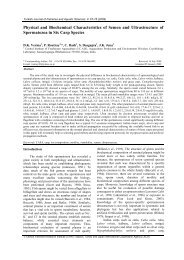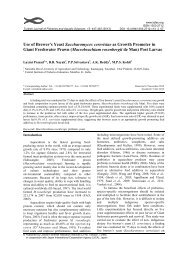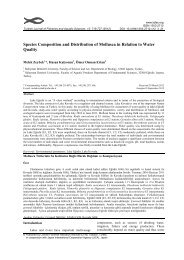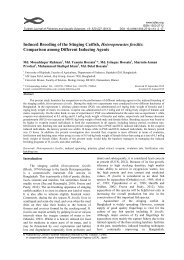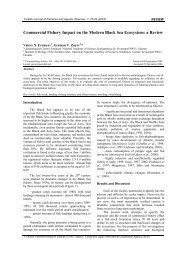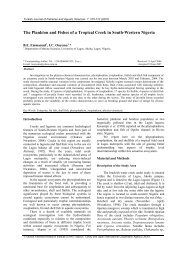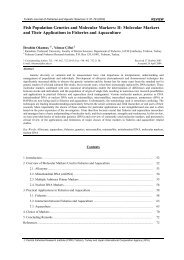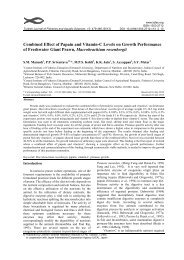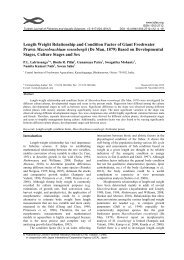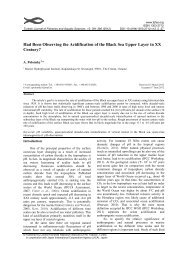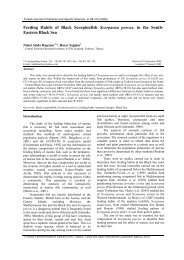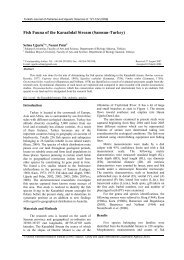Seasonal Variations in Condition Index and Gonadal Development ...
Seasonal Variations in Condition Index and Gonadal Development ...
Seasonal Variations in Condition Index and Gonadal Development ...
Create successful ePaper yourself
Turn your PDF publications into a flip-book with our unique Google optimized e-Paper software.
C. Sah<strong>in</strong> et al. / Turk. J. Fish. Aquat. Sci. 6: 155-163 (2006) 15725Temperature (C) (ºC)201510508Mar. Apr. May Jun. Jul. Aug. Sep. Oct. Nov. Dec. Jan. Feb.DO (mg/L)DO (mgl -1 )7620519Mar. Apr. May Jun. Jul. Aug. Sep. Oct. Nov. Dec. Jan. Feb.Sal<strong>in</strong>ity (ppt)181716151,2Mar. Apr. May Jun. Jul. Aug. Sep. Oct. Nov. Dec. Jan. Feb.1Cholorphyll-aa0,80,60,40,20Mar. Apr. May Jun. Jul. Aug. Sep. Oct. Nov. Dec. Jan. Feb.Figure 2. Monthly variations <strong>in</strong> temperature, dissolved oxygen, sal<strong>in</strong>ity, <strong>and</strong> chlorophyll of the study area.1211<strong>Condition</strong> <strong>Index</strong> <strong>in</strong>dex10987654Mar Apr May Jun Jul Aug Sep Oct Nov Dec Jan FebK1K2Figure 3. Monthly variations <strong>in</strong> two condition <strong>in</strong>dexes.
160 C. Sah<strong>in</strong> et al. / Turk. J. Fish. Aquat. Sci. 6: 155-163 (2006)Table 2. <strong>Gonadal</strong> development phases of males <strong>and</strong> percentage distributionMonths Male Uncerta<strong>in</strong> I II III IV V VIN % N % N % N % N % N %March - 20 20 100 - - - - - - - - - -April - 20 20 100 - - - - - - - - - -May 25 - - - 16 64 6 24 3 12 - - - -June 24 - - - 3 13 7 28 10 42 4 17 - -July 27 - - - - - 3 11 8 30 18 67 - -August 28 - - - - - - - 4 14 13 46 11 40September 15 14 14 48 - - - - - - 6 21 9 31October 2 28 28 93 - - - - - - - 2 7November - 20 20 100 - - - - - - - - - -December - 20 20 100 - - - - - - - - - -January - 20 20 100 - - - - - - - - - -February - 20 20 100 - - - - - - - - - -100100a) Beg<strong>in</strong>n<strong>in</strong>g (primordial) Phase: Follicule walls are develop<strong>in</strong>g<strong>and</strong> oocyts are formed.b) Develop<strong>in</strong>g (immature) phase. Folliculs diameter <strong>in</strong>creased <strong>and</strong>oocytes are gett<strong>in</strong>g filled.4040c) Matur<strong>in</strong>g (mature) stage. Follicules are filled with completelymature oocyts.d) Spent (spawn) phase: Follicules are start<strong>in</strong>g to loose theirtypical structure.40e) Full spent phase: Follicules are gett<strong>in</strong>g smaller, connectivetissue re-formed <strong>and</strong> oocytes <strong>in</strong> some follicules absorbed40f) Rest<strong>in</strong>g phase: Gonad <strong>and</strong> <strong>in</strong>terfolliculer areas are fully coveredby connective tissue.Figure 6. Gonad development phases <strong>in</strong> females.
C. Sah<strong>in</strong> et al. / Turk. J. Fish. Aquat. Sci. 6: 155-163 (2006) 16110040a) Beg<strong>in</strong>n<strong>in</strong>g (primordial) phase: Follicle form<strong>in</strong>g stage <strong>in</strong> theconnect<strong>in</strong>g tissue <strong>and</strong> <strong>in</strong>tensive spermatozoid carry<strong>in</strong>g stage <strong>in</strong> thefollicles.b) Develop<strong>in</strong>g (immature) phase: Spermatozoid b<strong>and</strong>s are formed<strong>and</strong> connect<strong>in</strong>g tissue dim<strong>in</strong>ishes <strong>in</strong> this stage.4040c) Matur<strong>in</strong>g (mature) phase: nter follicles connect<strong>in</strong>g tissuedisappeared <strong>and</strong> follicles reach to maximum size.d) Spent (Spawn) phase: Follicle walls are gett<strong>in</strong>g th<strong>in</strong>ner, structuredeformities start <strong>and</strong> spermatozoid amount <strong>in</strong>creases10040e) Full spent phase: Complete destruction of the follicle walls <strong>and</strong>gonad volume fast covered by the connect<strong>in</strong>g tissuef) Rest<strong>in</strong>g phase: Gonad area is fully covered by the connect<strong>in</strong>gtissue.Figure 7. Gonad development phases <strong>in</strong> males.competition) variables. All the environmentalvariables may affect the growth <strong>and</strong> reproduction aswell as the distribution of Anadara <strong>in</strong>aequivalvis.Among the biotic variables the chlorophyll-a, an<strong>in</strong>dicator of phytoplankton biomass <strong>and</strong> a very wellknown source of food for bivalve molluscs, washighly correlated with condition <strong>in</strong>dex dur<strong>in</strong>g thepresent study. Highest levels of chlorophyll-a content<strong>and</strong> condition <strong>in</strong>dex matched very well dur<strong>in</strong>g April –May. It is known that good condition values are the<strong>in</strong>dicators of accumulat<strong>in</strong>g nutrient reserves,particularly glycogen <strong>and</strong> prote<strong>in</strong>, <strong>and</strong> gonadaldevelopment (Dare <strong>and</strong> Edwards, 1975; Bligh <strong>and</strong>Dyar, 1984; Aldrich <strong>and</strong> Crowley, 1986) . In presentstudy, two peaks <strong>in</strong> condition <strong>in</strong>dex were observeddur<strong>in</strong>g annual cycle (Figure 3); major one <strong>in</strong> May <strong>and</strong>second one <strong>in</strong> November. Gradually decreas<strong>in</strong>gcondition <strong>in</strong>dex from May to August <strong>in</strong>dicatedsignificant loses <strong>in</strong> tissue weight or reserves due torelease of gametes. After August condition <strong>in</strong>dexstarted to rise gradually reach<strong>in</strong>g second peak <strong>in</strong>November when autumn blooms occurs <strong>in</strong> the area.This is a typical seasonal cycle observed <strong>in</strong> bivalves<strong>in</strong> subtropical <strong>and</strong> temperate regions (Iglesias <strong>and</strong>
162 C. Sah<strong>in</strong> et al. / Turk. J. Fish. Aquat. Sci. 6: 155-163 (2006)Navarro, 1991).It is reported that there have been importantchanges <strong>in</strong> the metabolic activities <strong>in</strong> pre/postreproduction period of the bivalve molluscs (Okumu,1993; Moscose et al., 1992; Narasimham, 1988b).Significant decl<strong>in</strong>es <strong>in</strong> prote<strong>in</strong> <strong>and</strong> lipid levels are<strong>in</strong>evitable dur<strong>in</strong>g spawn<strong>in</strong>g season. In contrastreserves such as glycogen <strong>and</strong> lipid are utilized dur<strong>in</strong>gthe w<strong>in</strong>ter when available food is limited. <strong>Seasonal</strong>variation <strong>in</strong> condition <strong>in</strong>dex also reflects this fact(Figure 4) (Aldrich <strong>and</strong> Crowley, 1986; Devenport<strong>and</strong> Chen, 1987; Okumu, 1993). The results of thepresent study also exhibited similar pattern. The lipidcontent reached maximum levels dur<strong>in</strong>g autumn <strong>and</strong>was used as energy reserve dur<strong>in</strong>g w<strong>in</strong>ter. Dur<strong>in</strong>g thespr<strong>in</strong>g gonadal development caused slight <strong>in</strong>crement<strong>in</strong> prote<strong>in</strong> content but not <strong>in</strong> lipid. That is becauselipid was used as energy source for accelerat<strong>in</strong>gmetabolism due to <strong>in</strong>creas<strong>in</strong>g temperature <strong>and</strong>gametogenesis (Figure 4).Observation of histological samples of gonads<strong>in</strong>dicated that spawn<strong>in</strong>g <strong>in</strong> the Black Sea populationof A. <strong>in</strong>aequivalvis took place dur<strong>in</strong>g summer period.Native bivalve species <strong>in</strong> the Black Sea spawn earlierthan A. <strong>in</strong>aequivalvis. It is most likely that A.<strong>in</strong>aequivalvis as a tropical species needs highertemperatures for spawn<strong>in</strong>g <strong>and</strong> larval development.<strong>Gonadal</strong> development stages for other species ofAnadara (i.e., A. granosa <strong>and</strong> A. rehombea) fromvarious localities have been described as rest<strong>in</strong>g,beg<strong>in</strong>n<strong>in</strong>g, develop<strong>in</strong>g, matur<strong>in</strong>g <strong>and</strong> spent <strong>and</strong>differentiations between these phases seem to quitesimilar (Dzyuba, 1982). Studies on A. subcrenata, A.broughtoni <strong>and</strong> A. ursi <strong>in</strong> sub-tropics showed thatspawn<strong>in</strong>g took place from June to September(Morton, 1990; Moscose et al., 1992; Dzyuba <strong>and</strong>Maslennikova, 1982; Cruz, 1984; Yankson, 1982;Hadfield, <strong>and</strong> Anderson, 1988; Cruz, 1987; Trol <strong>and</strong>Gomez, 1985). Dur<strong>in</strong>g the present study females withmature gametes were found until September <strong>and</strong>October, but their ratios decl<strong>in</strong>ed rapidly after August(Table 1, Table 2).Sex ratios of the specimens sampled weredeterm<strong>in</strong>ed monthly from the histological slides(Figure 5) as 1.04:1 (F/M) <strong>and</strong> 2 has shown that thereis no significant difference between sex ratio. The sexratio for other Anadara populations is given <strong>in</strong> Table3. It can be clearly seen that there is good agreementwith f<strong>in</strong>d<strong>in</strong>g of present study (Table 3).Determ<strong>in</strong>ation of first maturity length <strong>and</strong>spawn<strong>in</strong>g period are the basic requirements for theprotection <strong>and</strong> susta<strong>in</strong>able exploitation of the stocks.There are several methods used for study<strong>in</strong>g thesevariables, however the most precise results haveobta<strong>in</strong>ed through histological exam<strong>in</strong>ations. It isalmost impossible to determ<strong>in</strong>e the beg<strong>in</strong>n<strong>in</strong>g (II)period of the gonadal development us<strong>in</strong>g otherapproaches. In conclusion, the <strong>in</strong>troduced bivalvespecies has been adapted <strong>in</strong>to new environmentexhibit<strong>in</strong>g similar seasonal cycles <strong>in</strong> condition <strong>in</strong>dex<strong>and</strong> gametogenesis with other species of the genusAnadara <strong>in</strong>habit<strong>in</strong>g sub-tropic <strong>and</strong> temperate waters<strong>and</strong> other bivalve species <strong>in</strong> the Black Sea.ReferencesAldrich, J.C. <strong>and</strong> Crowley, M. 1986. <strong>Condition</strong> <strong>and</strong>Variability <strong>in</strong> Mytilus edulis (L.) From DifferentHabitats <strong>in</strong> Irel<strong>and</strong>, Aquaculture, 52: 273-286.Alpbaz, G.A. <strong>and</strong> Önen, M. 1991. Türkiye’de hraç EdilenKum Midyesi (Venus gall<strong>in</strong>a) Üzer<strong>in</strong>e Aratırma,E.Ü. Su Ürünleri Dergisi, 7: 78-86.AOAC. 1990. Official Methods of Analysis. In: K. Heldrich(Ed.), Association of Analytical Chemists. 15 thedition. AOAC: Arl<strong>in</strong>gton, Virg<strong>in</strong>ia, USA, 1289 pp.Bligh, E.G. <strong>and</strong> Dyar, W.J. 1984. Rapid Method of TotalLipid Extraction <strong>and</strong> purification, Canadian Journal ofBiochemistry Physiology, 37: 911-917.Broom, M.J. 1985. The Biology <strong>and</strong> Culture of Mar<strong>in</strong>eBivalve Molluscs of the Genus Anadara, ICLARMStudies <strong>and</strong> Rewiews, 209: 1-37.Cruz, R.A. 1984. Some Aspect of the Reproduction ofAnadara tuberculosa (Plecypoda: Arcidae) FromPunta Morales, Punterenas, Costa Rica, Rev. Biol.Trop., 32: 45-50.Cruz, R.A. 1987. The reproductive Cycle of the MangroveCockle Anadara gr<strong>and</strong>is (Bivalvia: Arcidae) <strong>in</strong> CostaRica, Brenesia, 27: 1-8.Dare, PJ. <strong>and</strong> Edwards, D.B. 1975. <strong>Seasonal</strong> Changes <strong>in</strong>Flesh <strong>and</strong> Weight <strong>and</strong> Biochemical Composition ofMussels (Mytilus edulis L.) <strong>in</strong> the Conwy Estuary,North Wales, J. Exp. Mar. Biol. Ecol., 18: 89-97Devenport, J. <strong>and</strong> Chen, X. 1987. A Comparison ofMethods For the Assessment of <strong>Condition</strong> <strong>in</strong> theMussel (Mytilus edulis L.), J. Moll. Stud., 53: 293-297.Dzyuba, S.M. <strong>and</strong> Maslennikova, L.A. 1982. Reproductivecycle of the Bivalve Mollusc Anadara broughtoniFrom the Southern Peter the Great Bay of the SeaJapan, Biol Morya., 3: 34-40.Table 3. Sex ratios <strong>in</strong> some Anadara speciesCountry Species Sex Ratio (F/M) ResearchersIndia A. granosa 1:1 Narasimham, 1988Costa Rica A. tuberculosa 1:1 Cruz, 1984Philipp<strong>in</strong>es A. antiquata 1.03:1 Toral, 1985East Africa A. senilis 1.2:1 Yankson, 1982Australia A. trabezia 1:1 Hadfield, 1988Costa Rica A. gr<strong>and</strong>is 1.2:1 Cruz, 1987Turkey A. <strong>in</strong>aequivalvis 1.04:1 This research
C. Sah<strong>in</strong> et al. / Turk. J. Fish. Aquat. Sci. 6: 155-163 (2006) 163FAO. 1996. Yearbook of Scientific Catches <strong>and</strong> Lend<strong>in</strong>g,1994; 74: Rome.Gicenberg, A.E. 1978. St<strong>and</strong>art, Method, For theExam<strong>in</strong>ation of Water <strong>and</strong> Wastewater, Edition,Lenore S. Clescesi., NO New York.Hadfield, A.J. <strong>and</strong> Anderson, D.T. 1988. ReproductiveCycles of Bivalve, Mollusca Anadara trapezia(Dashayes) Venerupis cerenata (Lamarck) <strong>and</strong>Anomia descripta iredale <strong>in</strong> the Sydney Region, Aust.J. Mar. Freshwat. Res., 39: 649-660Iglesias, J.I.P. <strong>and</strong> Navarro, E. 1991. Energetic of Growth<strong>and</strong> Reproduction <strong>in</strong> Cocles (Cerastoderma edule):<strong>Seasonal</strong> <strong>and</strong> Age- Dependent <strong>Variations</strong>, Mar<strong>in</strong>eBiology, 111: 359-368.Kim, Y.G. <strong>and</strong> Kang, Y.J. 1987. Cultur<strong>in</strong>g Density <strong>and</strong>Production of Ark Shell, Anadara broughtoni, Bull.Fish. Res. Dev. Agency, 36: 81-88.Lange, R., Friebe, R., Mitarbeit, F. <strong>and</strong> Schaffner, B. 1987.Zur Anwendung der Methodenkomb<strong>in</strong>ation Kjeldahl-Naßaufschluß/Berthelot-Reaktion bei derStickstoffbestimmung <strong>in</strong> biologischen Materialien 2.Nahrung, 23(5):549-559Morton, B. 1990. The Life Cycle <strong>and</strong> Sexual Strategy ofGafrarium pect<strong>in</strong>atum (Bivalvia: Veneridae) <strong>in</strong> HongKong Mangrove, Malacological Rewiew, 23: 53-62.Moscose, E.R., Pazo, J.P., Garcia, A. <strong>and</strong> Cortes, F.F. 1992.Reproductive Cycle Clam, Ruditapes philipp<strong>in</strong>arum(Adams, Reev, 1850) <strong>in</strong> Ria of Vigo (NW Spa<strong>in</strong>), Sci.Mar., 56: 61-67.Narasimham, K.A. 1988a. Biology of the Blood ClamAnadara granosa (L<strong>in</strong>neus) <strong>in</strong> Kak<strong>in</strong>ada Bay, J. Mar.Biol. Ass., 30: 137-150.Narasimham, K.A. 1988b. Biology of the Blood Clam,Anadara rehombea (Born) <strong>in</strong> Kak<strong>in</strong>ada Bay, J. Mar.Biol. Ass., 30: 134-135.Navarao, E., Iglesias, J.I.P. <strong>and</strong> Larranaga, A. 1989.Interannual Variation In the Reproductive Cycle <strong>and</strong>Biochemical Composition of the CockleCerastoderma edule From Mundace Estuary (Biscay,North Spa<strong>in</strong>), Mar<strong>in</strong>e Biology, 101: 503-511.Okumu, . 1993. Evaluation Suspended Mussel (Mytilusedulis L.) Culture <strong>and</strong> Integrated ExperimentedMariculture with Salmon <strong>in</strong> Scottish Sea Loch, PhD.Thesis, Stirl<strong>in</strong>g: University of Stirl<strong>in</strong>g.Parson, R.T., Maita, Y. <strong>and</strong> Lalli, C.M. 1984. Manual ofChemical And Biological Methods for Sea WaterAnalyses, Pergamons Press, Great Brita<strong>in</strong>.Sedano, F.J., Rodriquez, J.L. <strong>and</strong> Ruiz, C. 1995.Biochemical Composition <strong>and</strong> Fertilisation <strong>in</strong> theEggs of Mytilus galloprov<strong>in</strong>cialis (Lamarck), Journalof Experimental Mar<strong>in</strong>e Biology <strong>and</strong> Ecology, 192:75-85.Smith, B.H. 1968. Manuel of Histology Sta<strong>in</strong><strong>in</strong>g Methodsof the Armad Forces Institute of Pathology, ThirdEditor, Lee G. Luna., New York.ah<strong>in</strong>, C. 1995. Dou Karadeniz’de Akmidye (Anadaracorne Reev, 1844)’nın Bazı PopulasyonParametreler<strong>in</strong><strong>in</strong> Belirlenmesi Üzer<strong>in</strong>e Bir Aratırma,MSc. thesis, Trabzon: Black Sea TechnicalUniversity.ah<strong>in</strong>, C., Düzgüne, E., Mutlu, C., Aydın, M. <strong>and</strong> Emiral,H. 1999. Determ<strong>in</strong>ation of the Growth Parameters ofthe Anadara cornea R. 1844 Population By theBhattacharya Method In the Eastern Black Sea, Tr, J.of Zoology, 23: 99-105.Tarkan, N.A. 1991. Marmara Deniz’<strong>in</strong>de Ruditapesdecussatus (L., 1758)’un Biyolojisi Üzer<strong>in</strong>eAratırmalar, :Ü. Su Ürünleri Dergisi, 1(2): 29-42.Trol, B.L. <strong>and</strong> Gomez, E.D. 1985. Reproductive Cycle ofthe Cockle Anadara antiquata L. Clatagan, BatanGas, Philipp<strong>in</strong>es, J. Coast. Res., 3: 241-245.Yankson, K. 1982. Gonad Maturation <strong>and</strong> Sexuality <strong>in</strong> theWest African Blod Cockle, Anadara senilis (L.) J.Molluscan Stud., 48: 294-301.Zolotarev, V.N. <strong>and</strong> Zolotarev, P.N. 1987. BivalveCunearca cornea A New Element of the Fauna In theBlack Sea, Dokl. Akad. Nauk SSSR, 2: 501-504. (InRussian)



